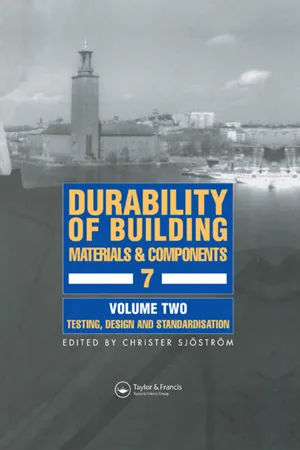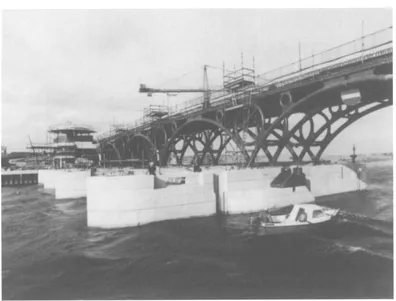
eBook - ePub
Durability of Building Materials and Components 7
Proceedings of the seventh international conference
- 1,400 pages
- English
- ePUB (mobile friendly)
- Available on iOS & Android
eBook - ePub
Durability of Building Materials and Components 7
Proceedings of the seventh international conference
About this book
These books contain articles on R&D into the major aspects of durability and service life prediction of building materials and components, as well as theoretical aspects of methods and modelling of prediction, description of degradation environment by use GIS, as practical implementation of knowledge on durability in maintenance procedures and in standardisation and regulations.
Frequently asked questions
Yes, you can cancel anytime from the Subscription tab in your account settings on the Perlego website. Your subscription will stay active until the end of your current billing period. Learn how to cancel your subscription.
At the moment all of our mobile-responsive ePub books are available to download via the app. Most of our PDFs are also available to download and we're working on making the final remaining ones downloadable now. Learn more here.
Perlego offers two plans: Essential and Complete
- Essential is ideal for learners and professionals who enjoy exploring a wide range of subjects. Access the Essential Library with 800,000+ trusted titles and best-sellers across business, personal growth, and the humanities. Includes unlimited reading time and Standard Read Aloud voice.
- Complete: Perfect for advanced learners and researchers needing full, unrestricted access. Unlock 1.4M+ books across hundreds of subjects, including academic and specialized titles. The Complete Plan also includes advanced features like Premium Read Aloud and Research Assistant.
We are an online textbook subscription service, where you can get access to an entire online library for less than the price of a single book per month. With over 1 million books across 1000+ topics, we’ve got you covered! Learn more here.
Look out for the read-aloud symbol on your next book to see if you can listen to it. The read-aloud tool reads text aloud for you, highlighting the text as it is being read. You can pause it, speed it up and slow it down. Learn more here.
Yes! You can use the Perlego app on both iOS or Android devices to read anytime, anywhere — even offline. Perfect for commutes or when you’re on the go.
Please note we cannot support devices running on iOS 13 and Android 7 or earlier. Learn more about using the app.
Please note we cannot support devices running on iOS 13 and Android 7 or earlier. Learn more about using the app.
Yes, you can access Durability of Building Materials and Components 7 by Christer Sjostrom in PDF and/or ePUB format, as well as other popular books in Architecture & Architecture Methods & Materials. We have over one million books available in our catalogue for you to explore.
Information
PART SIX
FIELD STUDIES AND
EVALUATION METHODS
90 IN-SERVICE PERFORMANCE OF REINFORCED CONCRETE IN THE TEES BARRAGE
K. Hollinshead, G.J. Osborne and D.J. Bigland
Construction and Materials Group, Building Research Establishment, Watford, Hertfordshire, UK
Abstract
A barrage has been constructed on the River Tees, near Stockton in the UK by the Teesside Development Corporation. Ground granulated blastfurnace slag cement was specified to meet the durability requirements of a 120 year life. BRE was commissioned to monitor the performance of the concrete in the barrage so that the body adopting the barrage can be given assurance that the structure will meet its design specifications. Upstream of the barrage the water is non-saline and will be maintained at a constant level. Downstream the water is saline and tidal, and epoxy coated reinforcing bars have been used.
Concrete test blocks have been cast on site from a concrete mix equivalent to that used in the barrage and these are exposed in up and downstream environments. The development over time of carbonation, chloride ingress, permeability and strength will be determined. Corrosion probes have been cast into test blocks and the walls of the up and downstream navigation lock waiting bays. Corrosion is not expected to occur within the timescale of the initial project (4 years) but these probes allow for the possibility of much longer term monitoring and will provide valuable baseline data for non-corroding steel.
Keywords: Durability, reinforced concrete, in-service monitoring.
1 Introduction
As part of a regeneration programme for Teesside in north east England a five pier concrete barrage carrying a tubular steel road bridge has been built by Teesside Development Corporation (TDC). The barrage controls the tidal waters of the River Tees to create a 22 km linear water park which will help to encourage development (Fig. 1). The £54m scheme also includes a canoe slalom course, navigation lock, fish pass and

Fig. 1 Tees Barrage
extensive landscaping.
BRE were commissioned by Montgomery Watson, the lead designers, on behalf of TDC to monitor and assess the long term durability of the concrete structures of the barrage over an initial four year period. At the end of this period responsibility for the barrage will pass to a another body with a commuted sum to cover the costs of maintaining the structure over its anticipated 120 year design life.
The aims of the assessment were to:
- identify potential deterioration processes of the barrage concrete structures,
- establish how the concrete is performing in-service in relation to the original design intent,
- establish whether the expected life of the concrete structures is likely to be achieved,
- provide guidance on the potential maintenance burden associated with the concrete structures,
- identify preventative maintenance works which would help to minimise maintenance costs for the concrete structures.
A suite of six papers by the clients, owners, designers and contractors have been published [1] dealing with the planning concept, economic justification, contractual arrangements, design and construction technicalities of the project, impact on the surrounding ecology, recreation, amenity and conservation. This paper describes a durability assessment programme which, while forming a small part of the overall project, could be of great importance in the development of systems for assessing and confirming durability service lives of concrete structures. The data available from the early stages of the programme are presented.
2 Assessment programme
2.1 Outline of assessment programme
The assessment programme for the barrage concrete has three main parts:
- a desk study of the mix design and materials used,
- characterisation of the concrete through testing of representative test cubes,
- collection of base-line electrochemical data from probes embedded in part of the structure and in test cubes.
Periodic visual inspections of parts of the barrage structure are also being undertaken but are not covered in this paper. The initial period available for assessment is relatively short and provision has been made for continuation of the programme after hand-over.
2.2 Desk study
The aim of this study was to assess the concrete mix design data, cementitious materials and aggregates in terms of whether they are likely to meet the requirement of a 120 year design life. The main points considered were:
- materials and concrete mix design,
- production and early curing of concrete,
- overall quality of concrete and supervision of placement and aftercare,
- aggressive environments and time of placing,
A number of measures were adopted to ensure durability of the structure, including use of 70% ground granulated blastfurnace slag (GGBS) as a cement addition (total cement content 400 kgm-3), maximum water to cement ratio of 0.4, use of fusion bonded epoxy coated rebar (FBECR) in parts of the structure exposed to estuarine water, general use of 75 mm cover with some reductions to 50 mm, crack control to 0.2 mm in accordance with BS 8007 [2] and a strictly applied regime of limitations on concrete temperatures during pouring and curing.
The use of GGBS and a low water to cement ratio offered a number of advantages:
- lower heat evolution during cement hydration which reduces the risk of thermal cracking,
- lower permeability concrete at later ages with decreased chloride ion penetration,
- longer term strength development,
- reduced costs and energy demands in production of material compared with OPC.
Temperature data from pours made during construction of the Barrage showed maxima of 50 to 60°C during summer months and 30 to 40 °C during March 1993 (the test cubes were cast in the same month one year later). The specified maximum temperature differential was 27°C and this was rarely exceeded. Curing typically took place at above 80% RH and above 10°C. The strength classification of the mix used was 42.5 MPa. In practice the 28 day strengths ranged from 45 to 70 Mpa.
Data from cover surveys were analysed and the values recorded were less than the minimum specified value in an average of only 2% of the locations tested, indicating that adequate care had generally been taken over the placement of the reinforcement.
2.3 Characterisation of concrete
Two types of test cubes were prepared for this purpose. Large cubes, 1 metre in dimension, and small cubes, 150 mm in dimension, were cast from a representative ready mix delivery. Four of the large cubes were instrumented with thermocouples at depths of 250, 500 and 750 mm, to monitor the changes in temperature over the first three days of curing. The large cubes were demoulded after four days and remained stored on site prior to being exposed to upstream (approximately constant level, fresh water) and downstream (tidal, estuarine water) river environments eleven and thirteen months respectively after casting.
Nine and seventeen months after casting 800 mm long, 100 mm diameter cores were extracted. The cores were cut into slices and tests for oxygen permeability (50 mm slices), compressive strength (105 mm slices) and chloride ingress (50 mm slice, from surface of specimens exposed to tidal zone only) performed. The smaller cubes were similarly exposed and a number of these were retrieved after three, nine and seventeen months. Similar tests were undertaken using the small cubes, either on whole cubes (compressive strength) or on cores extracted from them (oxygen permeability [3]). Prior to the oxygen permeability measurements all cores were conditioned in a dry CO2-free atmosphere for 28 days.
2.4 Corrosion monitoring probes
Although any corrosion of the reinforcement would be highly unlikely during the first four years of the life of the structure covered by the monitoring period, it was considered important to provide baseline electrochemical data and to have an option to continue beyond the initial period. Corrosion probes were designed by BRE and embedded in both part of the structure and a number of the large test cubes. The design of the probes was largely determined by the size of the reference electrode and, thereafter, by the maximum aggregate size (20 mm), the spacing of the reinforcement grid and the need for robustness. Each probe consists of a mild steel or FBECR working electrode, a Type 316 stainless steel counter electrode and an embedd...
Table of contents
- Cover
- Sponsors
- Full Title
- Copyright
- Contents
- Preface
- Technical Committee
- PART FIVE SERVICE LIFE DATA
- PART SIX FIELD STUDIES AND EVALUATION METHODS
- PART SEVEN SERVICE LIFE TESTING
- PART EIGHT DESIGN FOR DURABILITY
- PART NINE MAINTENANCE PLANNING AND PROCEDURES
- PART TEN STANDARDISATION AND REGULATIONS
- Author index
- Subject index